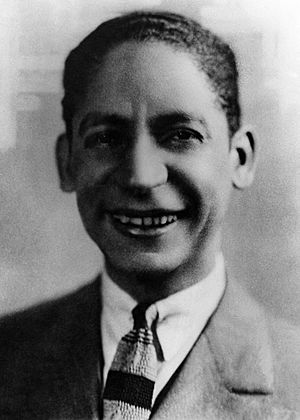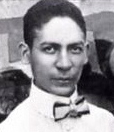Jelly Roll Morton facts for kids
Quick facts for kids
Jelly Roll Morton
|
|
|---|---|

Morton c. 1927
|
|
| Background information | |
| Birth name | Ferdinand Joseph LaMothe |
| Born | c. September 20, 1890 New Orleans, Louisiana, U.S. |
| Died | July 10, 1941 (aged 50) Los Angeles, California, U.S. |
| Genres | Jazz, ragtime |
| Occupation(s) | Musician, composer, arranger |
| Instruments | Piano |
| Years active | 1904–1941 |
| Labels | Victor, Gennett |
| Associated acts | Red Hot Peppers, New Orleans Rhythm Kings |
Ferdinand Joseph LaMothe (born around September 20, 1890 – died July 10, 1941), known as Jelly Roll Morton, was an American ragtime and jazz musician. He was a talented pianist, bandleader, and composer. Many people consider him one of the most important figures in early jazz.
Morton was one of the first people to arrange jazz music. This showed that jazz, which often involved musicians making up music on the spot, could also be written down. His song "Jelly Roll Blues" was published in 1915. It was one of the very first jazz songs ever printed. He also wrote other famous songs like "King Porter Stomp" and "Wolverine Blues". Morton was very confident and even claimed he invented jazz music in 1902!
Contents
About Jelly Roll Morton
His Early Life
Jelly Roll Morton was born Ferdinand Joseph LaMothe in New Orleans, Louisiana. He was part of the Creole community. The exact year he was born is a bit unclear, but it was around 1890. His father left when he was young. When his mother married William Mouton in 1894, Ferdinand took his stepfather's last name, changing it slightly to Morton.
His Music Career
Morton started playing piano when he was about 14 years old. Around 1904, he began traveling around the southern U.S. He played in minstrel shows and composed many songs. Some of his early songs include "Jelly Roll Blues" and "King Porter Stomp."
In 1915, "Jelly Roll Blues" became one of the first jazz songs to be officially published. This was a big step for jazz music. In 1917, Morton moved to California. His song "The Crave" became very popular there. He even played in Vancouver, Canada.
Morton returned to Chicago in 1923. He started making his first commercial recordings. He made piano rolls and records, both as a solo pianist and with jazz bands.
In 1926, Morton signed a contract with the Victor Talking Machine Company. This allowed him to record with his own band, called the Red Hot Peppers. These recordings are very famous today. They featured many talented jazz musicians.
Later, Morton moved to New York City. He continued to record, but it was harder for him to find musicians who wanted to play his style of jazz. His New York recordings were not as successful as his earlier ones.
Library of Congress Interviews
In 1935, Morton moved to Washington, D.C. He managed and played piano at a bar. In 1938, a folklorist named Alan Lomax met Morton. Lomax invited Morton to record his music and tell stories for the Library of Congress.
These recording sessions were meant to be short. But they turned into over eight hours of Morton talking and playing piano! He shared many stories about his early life in New Orleans and the history of jazz. Some of these recordings were not released until much later because they contained songs that were considered too grown-up for the time.
His Later Life and Death
Jelly Roll Morton passed away on July 10, 1941, in Los Angeles, California. Many musicians attended his funeral, including Kid Ory and Mutt Carey.
Personal Life
Morton married Mabel Bertrand in 1928. He was a very religious person and a devoted Catholic. His gravesite has a large rosary on it, showing his faith.
His Musical Style
Morton's piano style was a mix of early ragtime and a style called "shout." His playing was also similar to "barrelhouse" piano, which led to boogie-woogie music.
He had a unique way of playing the piano. He would often play the main tune with his right thumb. At the same time, he would play harmonies above those notes with his other fingers. This gave his music a special sound. He also used walking bass lines in his left hand.
Many of Morton's songs were tributes to himself, like "Winin' Boy" and "Mr. Jelly Lord." His song "King Porter Stomp," written many years earlier, became a huge hit for other bands like Fletcher Henderson and Benny Goodman. It became a very popular song that many swing bands played.
Awards and Honors
Jelly Roll Morton received many honors for his contributions to music:
- His Library of Congress interviews were released as a special collection. They won two Grammy Awards.
- He also received the Grammy Lifetime Achievement Award.
- Morton was inducted into the Rock and Roll Hall of Fame.
- He was also honored as a charter member of the Gennett Records Walk of Fame.
- In 2008, he was inducted into the Louisiana Music Hall of Fame.
Discography
- 1923/24 (Milestone, 1923–24)
- Red Hot Peppers Session: Birth of the Hot, The Classic Red Hot Peppers Sessions (RCA Bluebird, 1926–27)
- The Pearls (RCA Bluebird, 1926–1939)
- Jazz King of New Orleans (RCA Bluebird, 1926–30)
- Jelly Roll Morton: The Complete Library of Congress Recordings, Vols. 1–8 (8-CD Box Set) (Rounder, 2005)
See also
 In Spanish: Jelly Roll Morton para niños
In Spanish: Jelly Roll Morton para niños
- List of ragtime composers



